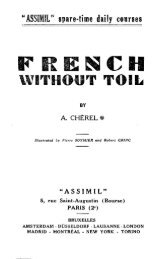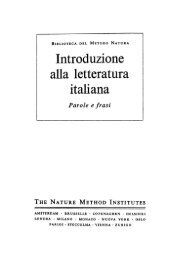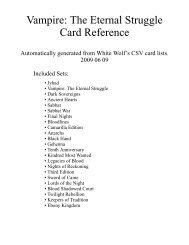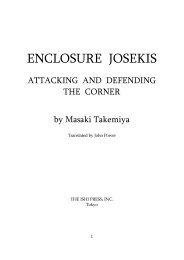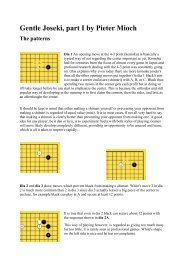Plains Cree: A Grammatical Study - Computer Science Club
Plains Cree: A Grammatical Study - Computer Science Club
Plains Cree: A Grammatical Study - Computer Science Club
You also want an ePaper? Increase the reach of your titles
YUMPU automatically turns print PDFs into web optimized ePapers that Google loves.
22 [TRANS. AMER. PHIL. SOC.<br />
S 9-6 ostikwan pikoh ka-pikiskwemakahk.<br />
head (O) only speak (AI inan(0))<br />
'It is a head only which talks.'<br />
When an otherwise inanimate noun becomes<br />
temporarily animate, the ambiguity under discussion<br />
may be removed entirely by the presence of modifiers;<br />
consider the demonstrative pronoun awa in<br />
S 54-42 nama ciy awa<br />
not (question) this (3)<br />
kitastotin ewako, "nik-dydwik!"<br />
your headgear(0/3) this (0/3) possess(TA 3-1)<br />
eh- iteyimit<br />
kitastotin ?<br />
think of him(TA 3-1) your headgear(0/3)<br />
'Is not this headgear of yours thinking this of me,<br />
"Let him possess me!" '<br />
The gender transfer discussed so far has a statable<br />
and largely predictable function. Furthermore, it is<br />
a one-way transfer, from inanimate to animate. It<br />
is thus quite distinct from the lack of gender concord<br />
that is occasionally encountered in the texts, e.g.,<br />
T 87-6 e-nitoniket oma sihta<br />
grope(AI 3) this(O) spruce(3)<br />
'he groped for that spruce'<br />
It may be relevant that such discrepancies seem to be<br />
particularly frequent with noun stems showing class-<br />
cleavage, e.g., mistikw- animate 'tree,' inanimate<br />
'stick'; note also the homonymy of 3' and Op discussed<br />
in 2.02.<br />
S 48-10 osdm miywdsin awa<br />
indeed be good(II 0) this(3)<br />
mistik ..<br />
stick (0)<br />
'indeed it is good, this piece of wood'<br />
T 76p7 kd-pasastehahk mistikwa ohi<br />
whip(TI 3) tree(3') this(3'/Op)<br />
'he whipped these trees'<br />
It remains to be seen whether such instances are<br />
really accidental slips of the tongue (or lapses of the<br />
record) or whether they perhaps point to features of<br />
the gender dimension which are not understood.<br />
2.32. Gender Classes of Nouns<br />
Gender is one of the basic criteria for the inflectional<br />
and derivational classification of verbs. Transitive<br />
animate and transitive inanimate stems largely come<br />
in pairs, differing as to the gender of the goal, e.g.,<br />
otinew 'he takes him,' otinam 'he takes it'; animate<br />
intransitive and inanimate intransitive stems similarly<br />
WOLFART: PLAINS CREE<br />
differ by the gender of the actor, e.g. ohpikiw 'he<br />
grows up,' ohpikin 'it grows up'; cf. also 5.1.<br />
In most instances, then, there is a choice, as to<br />
gender, among verb stems. Nouns are sharply<br />
different since most of them belong to only one gender<br />
(but see 2.323 below). Even when they are tempor-<br />
arily animate, showing agreement with animate<br />
verbs, their inflectional endings (as far as they are<br />
unambiguous) remain inanimate.<br />
2.321. Nouns which denote humans, animals,<br />
spirits, or trees are animate. E.g., ayahciyiniw<br />
'enemy, especially Blackfoot,' czpay 'dead person,<br />
corpse,' tahkohci 'On-Top' (personal name; there is<br />
also a particle tahkohci). mistatim 'horse,' mostos<br />
'buffalo.' dtayohkan (a certain kind of spirit),<br />
kise-manitow 'God.' sihta 'spruce,' mdyi-metos 'black<br />
popular,' mistik 'tree.'<br />
Also animate are extensions of these, e.g., ayisi-<br />
yinshkdn 'effigy, doll.'<br />
2.322. Also animate is a variety of objects some of<br />
which constitute relatively well-defined semantic<br />
groupings. By and large, the gender assignment of<br />
nouns in <strong>Cree</strong> seems to correspond fairly closely to<br />
that of MIenomini which Bloomfield has described in<br />
great detail (1962: pp. 28-36).<br />
Some body-parts are animate: nisakitikom 'my<br />
braid,' nitasiskitan 'my calf of leg,' nitihtikos 'my<br />
kidney,' nitlhiy 'my shoulder-blade,' niyihk 'my<br />
gland,' etc.<br />
Animal hides and garments made from them:<br />
waposwaydn 'rabbit skin,' mostoswaydn 'buffalo-robe,'<br />
maskwaydn 'bear skin,' etc.<br />
Certain plants and their products: mahtdmin 'grain<br />
of maize, ear of maize'; pahkwesikan 'bannock,'<br />
pzswehkasikan '(leavened) bread'; pikiw 'gum, rosin';<br />
ayoskan 'raspberry' (but not otehimin 'strawberry'),<br />
pitikomin 'dried prune,' pakdn 'nut'; etc.<br />
Tobacco and other items from its sphere: cistemdw<br />
'tobacco,' ospwdkan 'pipe,' ahpihcis 'tobacco-pouch.'<br />
Some natural objects (perhaps in relation to their<br />
function as atayohkan?; see T104): pisim 'sun, moon,'<br />
pisimohkdn 'clock, watch, "pseudo-sun,"' acdhkos<br />
'star'; asiniy 'rock, stone' (cf. 2.323 below); kona<br />
'snow,' maskwamiy 'ice'; soniydw 'gold, money'; etc.<br />
Some articles of personal or household use: askihk<br />
'kettle,' napwenis 'little frying pan' (loan from French<br />
la poele), kwapahikan 'ladle'; asdm 'snowshoe,'<br />
akwdndn 'shawl,' nitds 'my trousers' (but inanimate<br />
in the meaning 'my gaiter'); akwask 'knob-shaped<br />
arrow head,' pahpahahkwdn 'shield,' etc.<br />
Further and more specific groups may be set up,<br />
but their predictive value is obviously low. The<br />
above examples are given mainly to illustrate the<br />
wide range of animate nouns. In short, only a list<br />
can account for the gender of <strong>Cree</strong> nouns.<br />
2.323. Some noun stems are subject to class-<br />
cleavage, taking both animate and inanimate endings,<br />
e.g., akohp 'blanket,' askipwdw 'wild potato,' etc.<br />
The animate and the inanimate stem often have



